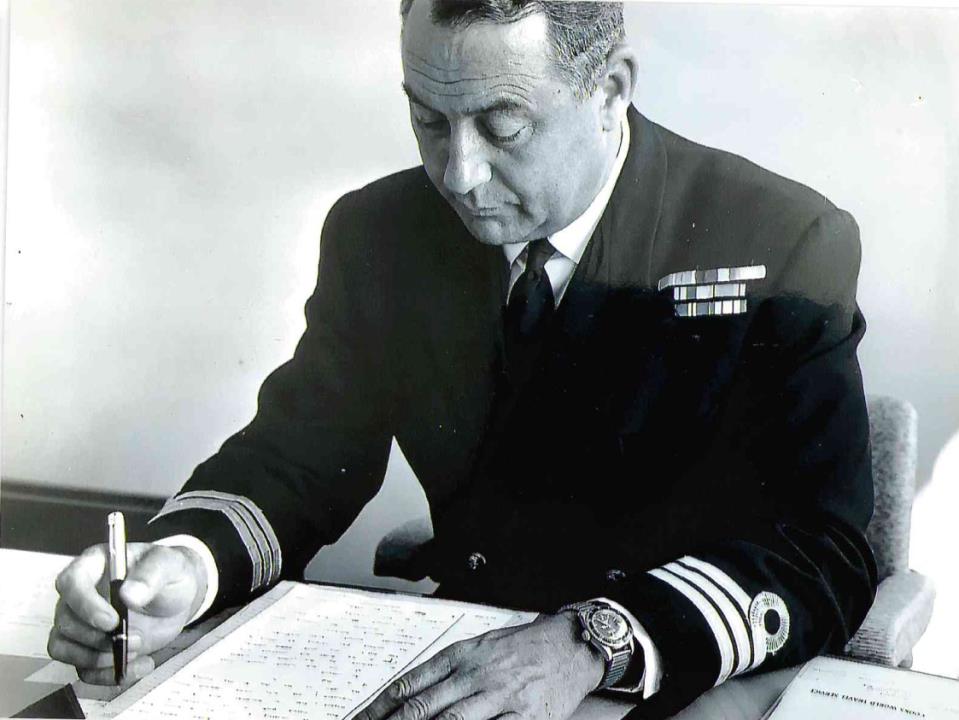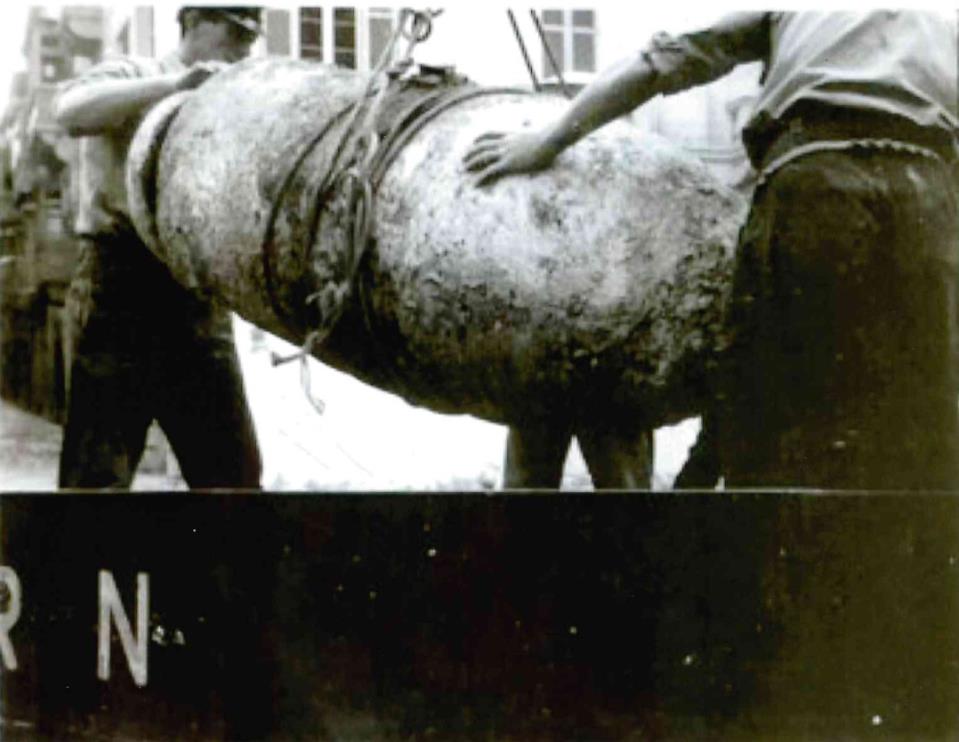It is a known piece of historical trivia that for a time during the Second World War, Malta was the most bombed place on the planet.
That’s evidenced by the fact that right up to this very day, bombs from back then continue to be unearthed. For instance, just last year an unexploded bomb from the war was found in a construction site in Ta’ Qali.
But no bomb dropped during the war came bigger than Hermann. The 2,200 pound bomb – roughly 1,000kg – was named by the Germans after their quite plump Luftwaffe commander Hermann Goring, and was capable of destruction on a major scale.
It was one of these bombs which the commander of the Mediterranean Fleet Clearance Diving Team Lieutenant Philip Arthur White (below) found himself dealing with right outside St John’s Co-Cathedral on 30 November 1955.
White’s two daughters, Jenny Harrison and Penny Bloxham, who were in Malta recently, have provided The Malta Independent on Sunday with new pictures of the dramatic incident, and White’s own personal account of it.

“The bomb was discovered by a Maltese bulldozer driver just outside the magnificent cathedral in Valletta; the capital of Malta. Had it exploded it would have destroyed the entire façade of the ancient cathedral and probably more,” White wrote in his account of the event.
“The bulldozer driver, as soon as he discovered what he had unearthed, took off to the nearest bar. With Malta being a 100% Catholic country, he no doubt gave thanks to the Almighty for his preservation en route to, during, and after his visit to the bar,” White’s account continued.
A Times of Malta report, which appeared on 1 December 1955, named the lucky worker as Victor Fenech from Naxxar, who was one of a team laying new sewage pipes in the area.
Back then, there would have been three major bomb clearance teams: one within the Navy, which is the one which White led and which was responsible for anything underwater, in the dockyards and in naval establishments; one within the Royal Air Force, which was responsible for anything on air force property, airfields and their own crashed aircraft on land and one within the Army, which was basically responsible for everything else.
“Territories are carefully guarded – no poaching,” White wrote.

However, it so happened that on that day that the bomb was discovered next to the Co-Cathedral, the Army’s Bomb Disposal officer was on leave, therefore leaving the Navy to step up to the plate and cover for him instead.
In his fascinating account, White details the process used to identify and ultimately secure the bomb.
“The first ‘golden rule’ of bomb and mine disposal is identification. This we thought was quite straight forward except for one thing. On the rear of the bomb was an object that completely foxed us. It was not in any of the books. It could have been a booby trap,” White wrote.
White, in fact, circled the strange device (below) in photos which he took – photos which have been shared with The Malta Independent on Sunday by his daughters.
“The man looking at it in the photo – Leading Seaman Brassington, Clearance Diver 2nd Class – on his own initiative, poked it with his finger. It fell off! We all froze… certain bomb fuses give you 16 seconds before detonation. In this case, with 2,000 pounds of explosive, a longer delay wouldn’t have mattered,” White wrote.
“It was then we discovered that it was the clock of a water main that had become attached to the bomb by age over the years. Breathe again!”

It wasn’t the first close call that Brassington – or indeed White himself had during their respective naval careers.
Michael John “Shiner” Brassington, who was born in West Ham in February 1936, joined the Navy at the tender age of 15 as a junior entrant for boy service, at HMS Ganges, on 4 September 1951.
Brassington nearly died during one of his first dives at the Naval Diving School, Chatham. He got stuck in three feet of mud, 30 foot down without a properly functioning oxygen supply. Having undertaken Clearance Diving training, Brassington was posted to the Mediterranean Fleet Clearance Diving (MFCD) Team based at Malta in April 1955.
The “beast”, as White describes it, was loaded onto a lorry, which was pictured driving down Castille Hill out of Valletta, and transferred to a landing craft. One of the commander-in-chief’s staff was invited to have a look at it and it was then taken out to sea and dumped.
“Actually we intended to take it further out but there was quite a swell running and on one particular heavy roll it broke away from the lashings and launched itself,” White wrote.
“Not in my report,” he added.

The incident was not White’s first close call while he served in the Navy either by any means: he was one of 1,208 officers aboard the HMS Royal Oak when the veteran battleship was struck by four German torpedoes at Scapa Flow six weeks into the Second World War.
Eight hundred and thirty-three of those 1,208 crew members perished, but White, who had just turned 19 a couple of weeks prior, was not among them.
He at first found himself buried under a press of bodies trapped in his mess deck by an inward opening screen door. He eventually managed to force his way onto the upper deck and stepped into the water as the ship capsized.
White struggled in the icy waters for two hours and was on the verge of succumbing to the cold seas when he heard a welcome “here’s one more” before being plucked out of the sea and onto a rescue boat.
Perhaps it says a lot about White’s character that he later regularly corresponded with one of the crew members of the German U-Boat, which had carried out the daring mission to sink the HMS Royal Oak.

Six years of service during the war followed for White, as he served on the HMS Aurora during the Norwegian campaign and the search for the German battleship Bismarck. He also served on several of the Arctic convoys to Murmansk and at the Naval headquarters in Alexandria in Egypt.
After the war, he served on board the HMS Vanguard as a petty officer – the same HMS Vanguard which took the Royal Family to and from South Africa for their royal tour – and Prince Philip was in fact one of White’s instructors when he was training to become a Commissioned Boatswain.
On being promoted to a Lieutenant, he served in Mine Countermeasures and then qualified as a Clearance diver in underwater bomb and mine disposal, which is what ultimately brought him to Malta in 1955.
In Malta, he led a team of 12 – known as the Mediterranean Fleet Clearance Diving Team – which disposed of some 900 bombs and mines, mainly underwater, ever year for three years.
Several newspaper clippings provided by White’s daughters show some of these disposal missions.
One clipping from 1956, for example, details a “double discovery in the dockyard” of two 500kg German aircraft bombs, which were both examined by White and his team. One was found to have been fuse-less, but the other was found to have a fuse still in it, which was duly removed.
“Among the participants in this minor drama in the Dockyard was a Maltese crane driver who, according to the Royal Navy bomb disposal experts, was positively rubbing his hands with pleasure at being able to help,” the clipping detailing the incident reads.

Another clipping from February 1958 writes of how White’s team recovered and defused some 100 pieces of explosive ordinance, ranging from anti-invasion mines, an Italian torpedo and German 1,000, 500 and 250 pound bombs, in the space of seven working days.
The team was also involved in the 1956 invasion of the Suez Canal and carried out bomb disposal missions in Benghazi, Libya, where one notable highlight was the neutralising of a 1,500 pound German acoustic-magnetic mine from the harbour.
White was honoured for his work by Queen Elizabeth II who appointed him a Member of the Order of the British Empire (MBE).
White’s time in Malta is not just known for his work in clearing explosives: he and his team also made the news for taking part as stunt extras in the 1958 film The Silent Enemy, which tracked the life of navy frogman Lionel "Buster" Crabb who disappeared mysteriously in 1956.
The British secret service MI6 had recruited Crabb on 19 April 1956 to investigate the Soviet cruiser Ordzhonikidze that had brought head of state Nikita Khrushchev and Nikolai Bulganin on a diplomatic mission to Britain. According to Peter Wright in his book Spycatcher (1987), Crabb was sent to investigate Ordzhonikidze's propeller, a new design that Naval Intelligence wanted to examine. Crabb dived into Portsmouth Harbour and his MI6 controller never saw him again.
It was Crabb’s war-time exploits which were the subject of The Silent Enemy and White himself was tasked with being the stunt double for Laurence Harvey, who played Crabb in the film. This involved White having to grow out a moustache and beard and having to take part in several underwater scenes around the island.
White ultimately went on to have a Navy career which spanned until 1970, and travelled the world with his second wife. He worked in places such as Rhode Island, California, Hawaii – where he appeared in 18 episodes of Hawaii Five-O, Portugal, Japan and New Zealand.
He passed away on 5 June 2013, at the age of 92.